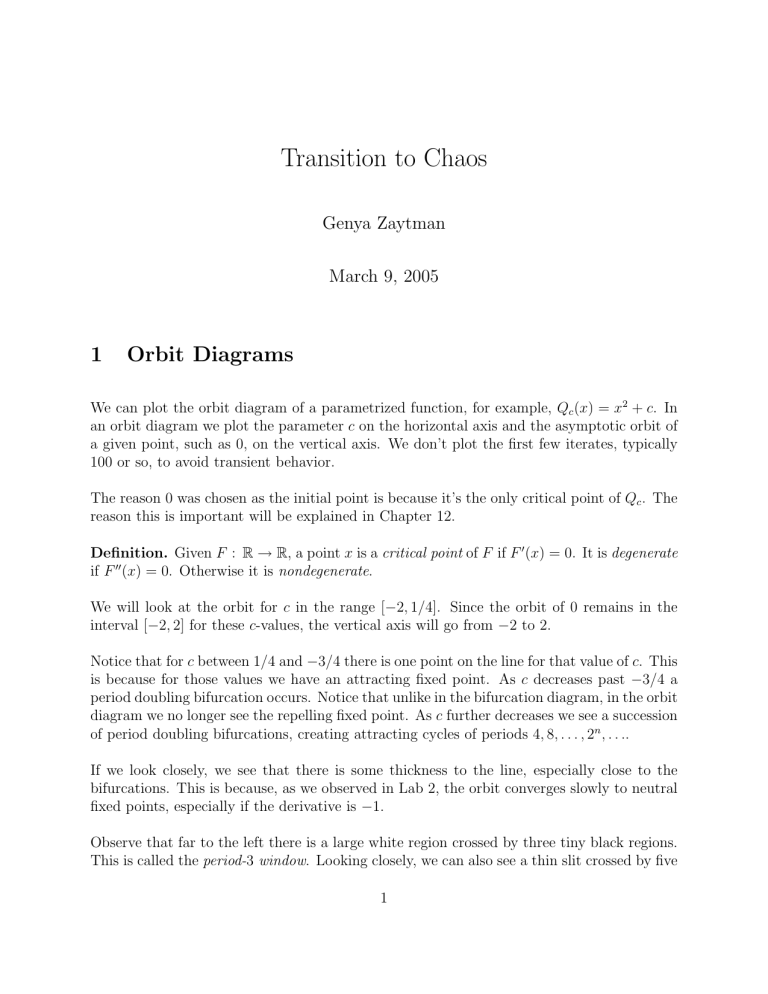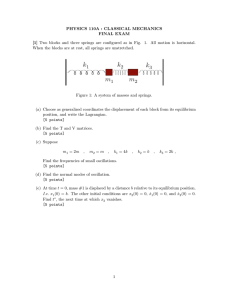Document 13584228

Transition to Chaos
Genya Zaytman
March 9, 2005
1 Orbit Diagrams
We can plot the orbit diagram of a parametrized function, for example, Q c
( x ) = x 2 + c . In an orbit diagram we plot the parameter c on the horizontal axis and the asymptotic orbit of a given point, such as 0, on the vertical axis. We don’t plot the first few iterates, typically
100 or so, to avoid transient behavior.
The reason 0 was chosen as the initial point is because it’s the only critical point of Q c
. The reason this is important will be explained in Chapter 12.
Definition. Given F :
R
→
R
, a point x is a critical point of F if F if F
��
( x ) = 0. Otherwise it is nondegenerate .
�
( x ) = 0. It is degenerate
We will look at the orbit for c in the range [ − 2 , 1 / 4]. Since the orbit of 0 remains in the interval [ − 2 , 2] for these c values, the vertical axis will go from − 2 to 2.
Notice that for c between 1 / 4 and − 3 / 4 there is one point on the line for that value of c . This is because for those values we have an attracting fixed point. As c decreases past − 3 / 4 a period doubling bifurcation occurs. Notice that unlike in the bifurcation diagram, in the orbit diagram we no longer see the repelling fixed point. As c further decreases we see a succession of period doubling bifurcations, creating attracting cycles of periods 4 , 8 , . . . , 2 n , . . .
.
If we look closely, we see that there is some thickness to the line, especially close to the bifurcations. This is because, as we observed in Lab 2, the orbit converges slowly to neutral fixed points, especially if the derivative is − 1.
Observe that far to the left there is a large white region crossed by three tiny black regions.
This is called the period 3 window . Looking closely, we can also see a thin slit crossed by five
1
tiny blank regions. Under magnification we can see other windows with different number of thin black regions. Note that in each of these period n windows we again see a cascade of period doubling bifurcations. In fact, under magnification they look similar to the original orbit diagram. Hence, we see a selfsimilarity in the orbit diagram, magnifying certain portions of the orbit diagram produces pictures that look similar to the whole diagram.
Also notice that the curves connecting periodic points are continuous in c . These cycles never jump, which might indicate the existence of other attracting cycles. Since we only compute one seed, it is still possible there are other attracting cycles to which 0 isn’t attracted.
However, these results suggest that there is only one attracting cycle.
Also notice the large black region itself. Thus there appear to be many c values for which the orbit of 0 doesn’t settle onto any attracting cycle.
The orbit diagram for other functions exhibit similar properties. The logistic function
F
λ
( x ) = λx (1 − x ) with λ in the interval [1 , 4] and x in the interval [0 , 1] gives an orbit diagram that looks like a mirror image of the orbit diagram for Q c
.
2 The PeriodDoubling Route to Chaos
We can gain insight into the reason for period doubling by looking at the graphs of Q c and its iterates for various values of c . In particular we can look at the graphs of Q c with c values corresponding to the various dynamical behaviors we have studied. The interesting dynamics are on the interval [ − p
+
, p
+
]. Let q be the point to the left of p
− mapped to it by
Q c
. Then we observe that we can find, different, c values such that the graphical analysis diagrams of Q 2 c
Q c over [ − p
+
, p
+ over the interval [
]. q, p
−
] looks similar to the graphical analysis diagrams of
Since the graphs of Q 2 c restricted to the interval [ q, p
−
] resemble those of the quadratic functions, we expect their second iterates to also look similar. Thus we expect there to be a subinterval of [ q, p
−
] over which the graph of Q
4 c looks like Q c and undergoes the same sequence of bifurcations as c decreases. This agrees with what we observe in the orbit diagram. Repeating this renormalization process we see that at the n th tiny subinterval where Q
2 n c stage we can find a resembles the original function and thus makes a transition from saddlenode (actually, a perioddoubling for the previous period viewed from one side), to perioddoubling, and to a chaotic regime. This accounts for the selfsimilarity of the orbit diagram.
2





